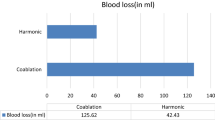Abstract
The harmonic scalpel has been in use for tonsillectomy for the last 5–6 years in western Europe and North America. Although some studies have found this technique to be superior to other conventional methods, its use is still not very popular. In this single-blinded prospective study, the intraoperative events and postoperative morbidity after the use of harmonic scalpel in tonsillectomy (HST) was evaluated in 180 cases in two hospitals and compared with conventional steel tonsillectomy (CST) and hemostasis secured by bipolar diathermy or ligatures in 100 cases. Both bipolar diathermy and ligatures were used to control the intraoperative bleeding in all cases of CST and some cases ( n =9) of HST. The study was done in two hospitals. Patients were randomized irrespectively of their age, sex, past history or indication for surgery. The total number of patients operated on was 180 for HST and 100 for CST. The surgical duration, intraoperative blood loss and postoperative pain were compared between the patients who only had tonsillectomy done in either group ( n =120 in HST and n =70 in CST). The mean operative time in the HST group was not longer than the CST group, but the intraoperative blood loss was significantly less in the HST group. Postoperative pain was present in all patients in the HST group, but to a lesser extent than in the CST group. There was no major postoperative hemorrhage in the HST group that required surgical attention. HST has the advantage over CST when secondary hemorrhage after tonsillectomy is considered. Thus, following the results of the National Prospective Tonsillectomy Audit (NPTA), it may be safe to say that HST is superior to most other conventional methods in reducing secondary hemorrhage. The use of disposable blades in CST certainly reduces the risk of the transmission of Cruetzfield-Jacob disease (CJD).

Similar content being viewed by others
References
Koempel JA (2002) On the origin of tonsillectomy and the dissection method. Laryngoscope 112:1583–1586
Wiatrak BJ, Willging JP (2002) Harmonic scalpel for tonsillectomy. Laryngoscope 112:14–16
Morgenstein SA, Jacobs HK, Brusca PA, Consiglio AR, Donzelli J, Jakubiec JA, Donat TL (2002) A Comparison of tonsillectomy with the harmonic scalpel versus electrocautery. Otolaryngol Head and Neck Surg 127:333–338
Walker RA, Syed ZA (2001) Harmonic scalpel tonsillectomy versus electrocautery tonsillectomy: A comparative pilot study. Otolaryngol Head and Neck Surg 125:449–455
Akural EI, Koivunen PT, Teppo H, Alhuhta SM, Lopponen HJ (2001) Post-tonsillectomy pain: a prospective, randomized and double-blinded study to compare an ultrasonically activated scalpel technique with the blunt dissection technique. Anesthesia 56:1045–1050
Sood S, Corbridge R, Powles J, Bates J, G, Newbegin CJR (2001) Effectiveness of the ultrasonic harmonic scalpel for tonsillectomy. Ear Nose Throat J 80:514–518
Amaral JF (1994) Ultrasonic dissection. Endosc Surg Allied Technol 2:181–185
Haegner U, Handrock M, Schade H (2002) Ultrasound tonsillectomy, in comparison with conventional tonsillectomy. HNO 50:836–843
McCarus SD (1996) Physiological mechanism of ultrasonically activated scalpel. J Am Assoc Gynaecol Laparosc 3:601–608
Meulen JVD (2004) Clinical Effectiveness Unit, RCS England, London. National prospective tonsillectomy audit. Tonsillectomy technique as a risk factor for postoperative haemorrhage. Lancet 364:697–702
Lowe D (2004) Clinical research fellow. 78696622. The RCS, England March 2004. Interim Report. National Prospective Tonsillectomy Audit
Watson MG, Dawes PJ, Samuel PR (1993) A study of haemostasis following tonsillectomy comparing ligatures and diathermy. J Laryngol Otol 107:711–715
Acknowledgements
We are extremely grateful to Dr. S. Sarwat Kamal BSc MBBS, surgical trainee SHO at the Maritime Hospital, Medway, Kent, for revising the manuscript and carrying out the statistical analysis.
Author information
Authors and Affiliations
Corresponding author
Rights and permissions
About this article
Cite this article
Kamal, S.A., Basu, S., Kapoor, L. et al. Harmonic scalpel tonsillectomy: a prospective study. Eur Arch Otorhinolaryngol 263, 449–454 (2006). https://doi.org/10.1007/s00405-005-1022-2
Received:
Accepted:
Published:
Issue Date:
DOI: https://doi.org/10.1007/s00405-005-1022-2




